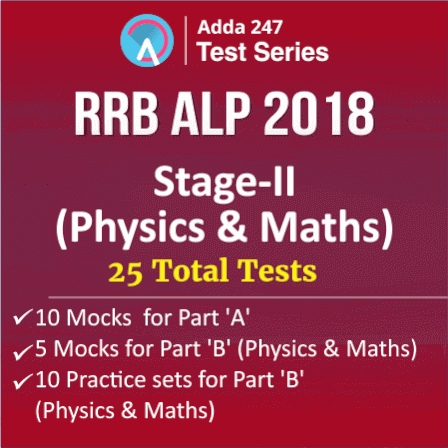Looking forward to providing you the best apt study content for every government exam at no cost thus making access to the exam content convenient for you, SSCADDA is available once again to assist you thoroughly in Railway ALP Stage 2 Exam 2018 where the motive is to enable you with Physics detailed notes on definitions, concepts, laws, formulae, rules and properties, important from the exam point of view. Stay in tune with SSCADDA to utilize the remaining time for Railway ALP Stage 2 and maximize your practice skills.
ELECTRICAL ENERGY AND POWER
The rate at which electric energy is dissipated or consumed in an electric circuit is termed as electric power.
The power P is given by
P = VI
Or P = I²R = V²/R
The SI unit of electric power is watt (W). It is the power consumed by a device that carries 1 A of current when operated at a potential difference of 1 V. Thus,
1 W = 1 volt × 1 ampere = 1 V A
The commercial unit of electric energy is kilowatt hour (kW h), commonly known as ‘unit’
CELLS IN SERIES AND IN PARALLEL
Cell: A cell is a device which generates electricity by using chemical energy. A cell has two electrodes, called the positive (P) and the negative (N),immersed in an electrolytic solution where the electrodes exchange charges with the electrolyte.
Note:-
EMF (Electromotive force): It is defined as the potential difference between electrodes when there is no current in the cell.
- Emf of the cell initiates the flow of current in the cell.
Internal Resistance: It is the resistance offered by the electrolyte and electrodes when the current flows. It is denoted by 'r'
Cells in Series
When multiple cells are arranged in such a way that the positive terminal of one cell is connected to the negative terminal of the other cell and so on, it is known to be in series combination.
For two cells of emf’s E1 and E2 connected in series with r1, r2 as their internal resistances, the formula is given as:
E equivalent = E1 + E2
r equivalent = r1 + r2
The rule for cells arranged in series combination:
(i) The equivalent emf of a series combination of n cells is just the sum of their individual emf’s, and
(ii) The equivalent internal resistance of a series combination of n cells is just the sum of their internal resistances.
Cells in Parallel
When cells are arranged in such a way that the positive terminals of all the cells are connected together and all the negative terminals are connected together, it is known to be in parallel combination.
For two cells of emf’s E1 and E2 connected in parallel with r1, r2 as their internal resistances, the formula is given as:
1/r equivalent = 1/r₁ + 1/r₂
E equivalent/ r eq = E₁/r₁ + E₂/r₂
Important Note:-
Example:


You may also like to read:
ELECTRICAL ENERGY AND POWER
The rate at which electric energy is dissipated or consumed in an electric circuit is termed as electric power.
The power P is given by
P = VI
Or P = I²R = V²/R
The SI unit of electric power is watt (W). It is the power consumed by a device that carries 1 A of current when operated at a potential difference of 1 V. Thus,
1 W = 1 volt × 1 ampere = 1 V A
The commercial unit of electric energy is kilowatt hour (kW h), commonly known as ‘unit’
CELLS IN SERIES AND IN PARALLEL
Cell: A cell is a device which generates electricity by using chemical energy. A cell has two electrodes, called the positive (P) and the negative (N),immersed in an electrolytic solution where the electrodes exchange charges with the electrolyte.
Note:-
- Current flows from cathode to anode through external circuit.
- Current flows from anode to cathode through electrolyte.
EMF (Electromotive force): It is defined as the potential difference between electrodes when there is no current in the cell.
- Emf of the cell initiates the flow of current in the cell.
Internal Resistance: It is the resistance offered by the electrolyte and electrodes when the current flows. It is denoted by 'r'
Cells in Series
When multiple cells are arranged in such a way that the positive terminal of one cell is connected to the negative terminal of the other cell and so on, it is known to be in series combination.
For two cells of emf’s E1 and E2 connected in series with r1, r2 as their internal resistances, the formula is given as:
E equivalent = E1 + E2
r equivalent = r1 + r2
The rule for cells arranged in series combination:
(i) The equivalent emf of a series combination of n cells is just the sum of their individual emf’s, and
(ii) The equivalent internal resistance of a series combination of n cells is just the sum of their internal resistances.
Cells in Parallel
When cells are arranged in such a way that the positive terminals of all the cells are connected together and all the negative terminals are connected together, it is known to be in parallel combination.
For two cells of emf’s E1 and E2 connected in parallel with r1, r2 as their internal resistances, the formula is given as:
1/r equivalent = 1/r₁ + 1/r₂
E equivalent/ r eq = E₁/r₁ + E₂/r₂
Important Note:-
- Cells are arranged in series to increase the voltage.
- Cells are increased in parallel to increase the current.
Example:
You may also like to read:



No comments:
Post a Comment